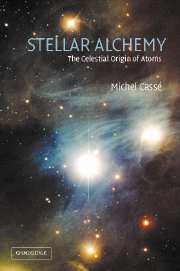Book contents
- Frontmatter
- Contents
- Preface
- Acknowledgements
- 1 Nuclear astrophysics: defence and illustration
- 2 Light from atoms, light from the sky
- 3 Visions
- 4 Contents of the sky: atomic sources and fountains
- 5 Nuclear suns
- 6 Sociology of stars and clouds
- 7 Histories
- 8 Ancient stars in the galactic halo
- 9 Conclusion
- Appendix 1 Invisible matter and energy
- Appendix 2 Supernovas and cosmology
- Appendix 3 Explosions
- Appendix 4 Stellar nucleosynthesis
- Appendix 5 Galactic evolution
- Appendix 6 Key dates
- Appendix 7 Constants and units
- Appendix 8 Websites
- Bibliography
- Index
Appendix 4 - Stellar nucleosynthesis
- Frontmatter
- Contents
- Preface
- Acknowledgements
- 1 Nuclear astrophysics: defence and illustration
- 2 Light from atoms, light from the sky
- 3 Visions
- 4 Contents of the sky: atomic sources and fountains
- 5 Nuclear suns
- 6 Sociology of stars and clouds
- 7 Histories
- 8 Ancient stars in the galactic halo
- 9 Conclusion
- Appendix 1 Invisible matter and energy
- Appendix 2 Supernovas and cosmology
- Appendix 3 Explosions
- Appendix 4 Stellar nucleosynthesis
- Appendix 5 Galactic evolution
- Appendix 6 Key dates
- Appendix 7 Constants and units
- Appendix 8 Websites
- Bibliography
- Index
Summary
Nuclear evolution
In the twentieth and twenty-first centuries, humankind has turned its attention not only to the energy of matter and attempts to master it, but also to the origin and evolution of the elements that make it up.
Nuclear evolution precedes and determines the evolution of life, and is itself preceded by the evolution of elementary particles. Such is the great scheme of material things. The idea of universal unity can only be strengthened by this knowledge. In this physical genesis, the star plays a crucial intermediate role between the Big Bang and life, and for this reason we owe it our closest attention.
The birth certificate of any member of the stellar society carries one of the three following comments:
alone or accompanied;
mass;
metallicity.
Masses range between 0.1 and 100 M⊙ and metallicities from one-thousandth of the solar value up to the latter. Metallicity is a question of generation. It may be taken as our leitmotif that the most ancient of stars are also the poorest in metals.
This therefore defines the stellar condition. Binary stars behave differently to single stars, as is clear from the case of the type Ia supernovas. In order to simplify, let us leave them aside for the moment and consider the case of the only child.
- Type
- Chapter
- Information
- Stellar AlchemyThe Celestial Origin of Atoms, pp. 220 - 223Publisher: Cambridge University PressPrint publication year: 2003



